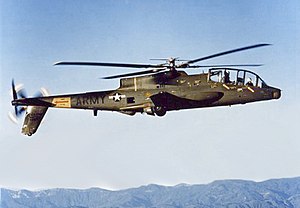
Back لوكهيد إيه إتش 56 شايان Arabic Lockheed AH-56 German Lockheed AH-56 Cheyenne Spanish لاکهید ایاچ-۵۶ شاین Persian Lockheed AH-56 Cheyenne French Lockheed AH-56 Cheyenne Galician AH–56 Cheyenne Hungarian Lockheed AH-56 Cheyenne ID Lockheed AH-56 Cheyenne Italian AH-56 シャイアン Japanese
| AH-56 Cheyenne | |
|---|---|

| |
| AH-56 Cheyenne during testing | |
| Role | Attack compound helicopter |
| National origin | United States |
| Manufacturer | Lockheed Corporation |
| First flight | 21 September 1967 |
| Status | Canceled |
| Primary user | United States Army |
| Produced | 1967–1969 |
| Number built | 10 |
The Lockheed AH-56 Cheyenne is an attack helicopter developed by Lockheed for the United States Army. It rose from the Army's Advanced Aerial Fire Support System (AAFSS) program to field the service's first dedicated attack helicopter. Lockheed designed the Cheyenne using a four-blade rigid-rotor system and configured the aircraft as a compound helicopter with low-mounted wings and a tail-mounted thrusting propeller driven by a General Electric T64 turboshaft engine. The Cheyenne was to have a high-speed dash capability to provide armed escort for the Army's transport helicopters, such as the Bell UH-1 Iroquois.
In 1966, the Army awarded Lockheed a contract for ten AH-56 prototypes, but as a stopgap also ordered the less complex Bell AH-1G Cobra as an interim attack aircraft for combat in Vietnam War. The AH-56's maiden flight took place on 21 September 1967. In January 1968, the Army awarded Lockheed a production contract, based on flight testing progress. A fatal crash and technical problems affecting performance put the helicopter's development behind schedule, resulting in the cancellation of the production contract on 19 May 1969.[1] Development of the Cheyenne continued in the hope that the helicopter would eventually enter service.
As American involvement in the Vietnam War was winding down, the Army canceled the Cheyenne program on 9 August 1972. By this time, the AH-1 Cobra was widely deployed by the Army in South Vietnam and equipped with the TOW anti-tank missile. Controversy with the United States Air Force over the Cheyenne's role in combat[2] as well as the political climate regarding military acquisition programs had caused the Army to amend the service's attack helicopter requirements in favor of a twin-engine conventional helicopter, viewed as less technical and more survivable.[3] The Army announced a new program for an Advanced Attack Helicopter (AAH) on 17 August 1972,[4] which led to the development of the Hughes AH-64 Apache.
- ^ OAVCSA 1973, p. 7.
- ^ Horwood, Ian (2006). Interservice Rivalry and Air Power in the Vietnam War (PDF). Combat Studies Institute Press. pp. 131–134. Archived from the original (PDF) on 13 August 2011.
- ^ Robb 2006, p. 47.
- ^ OAVCSA 1973, p. 9.
© MMXXIII Rich X Search. We shall prevail. All rights reserved. Rich X Search